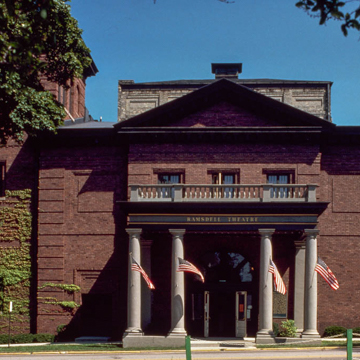The Ramsdell Theatre and Hall is the finest of several opera houses built in small Michigan cities at the turn of the twentieth century, including the Calumet Theater ( HO17.7) and the Kerridge Theater in Hancock (demolished). The Ramsdell was substantially built, beautifully decorated, and possessed the latest electrical devices, heating, ventilation, and fire protection.
Thomas Jefferson Ramsdell (1833–1917), Manistee's first lawyer and a civic leader, brought art and culture to Manistee with this gift to the city. In planning this civic monument, he set out to build a modern theater of “Grecian architecture” capable of accommodating any troupe; he also included an assembly hall. Like others in Manistee, he turned to a Chicago architect—in this case, Beman—for the ambitious neoclassical design.
The theater is flanked on the north by the assembly hall; the juncture of their distinct masses is marked by a square campanile tower. The stage house and scene loft rises seventy-five feet at the rear. The facade of the theater is accented by a pedimented central pavilion. The entrance is in the center, fronted by a flat-topped portico of coupled Doric columns. A dentiled and modillioned cornice beneath the hipped roof and the brick quoins at the corners detail the red brick building.
The auditorium seating is arranged in a horseshoe shape beneath a domed ceiling with a graded first floor and two tiers of boxes and galleries; it holds 1,200 people. It is elegantly decorated in light green and gold. Scenic artist Walter Wilcox Burridge painted on the drop curtain a scene entitled A Grove Near Athens; Frederic Winthrop Ramsdell, the Beaux-Arts-trained son of the theater's donor, painted murals of Arcady in the lobby and of Venus in the dome of the auditorium. The social hall holds a huge oak wood-paneled dance hall around which chairs are placed on a slightly raised dais; it also has an orchestra balcony. The dance hall is above the lobby, parlors, dressing rooms, and kitchen of the first floor.
Manistee was already recognized as a theater town because it was easily accessible by lake ferry from Wisconsin, was close to Cadillac and Traverse City for troupes on a circuit, and enjoyed a cool climate—thereby permitting a summer show season—so the completion of the Ramsdell Theatre assured its position as the premier theater town in the area. Planned as a venue for “serious” theater, as opposed to comedy and melodrama, the Ramsdell was purchased by Butterfield Theatres in the 1920s but was never converted to sound. The Ramsdell has been owned by the city since 1943. Restoration undertaken by the Manistee Art Institute and Manistee Civic Players in 2003 created a year-round cultural arts and community center. Conrad Schmidt Studios did much of the decorative painting.















